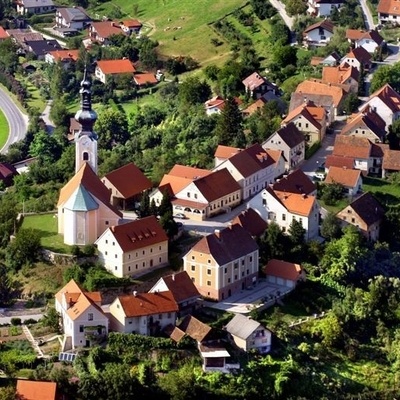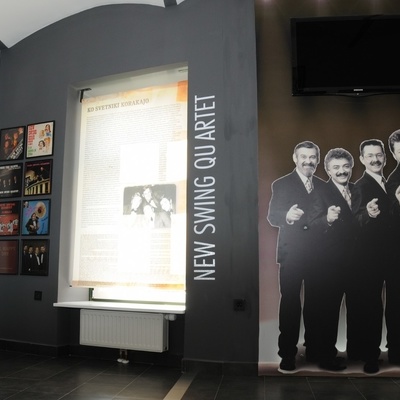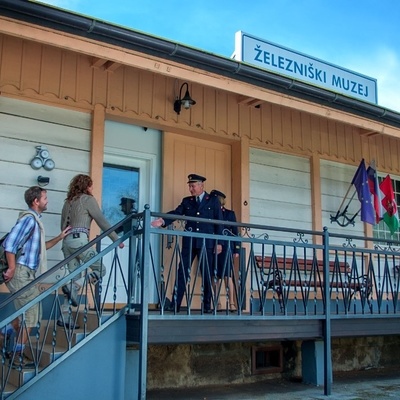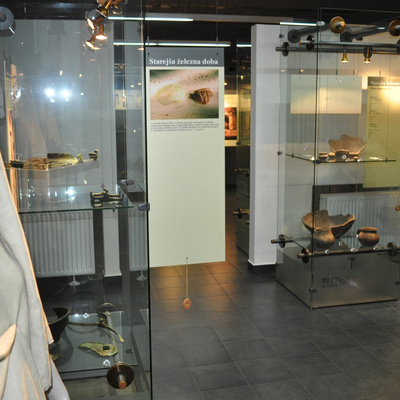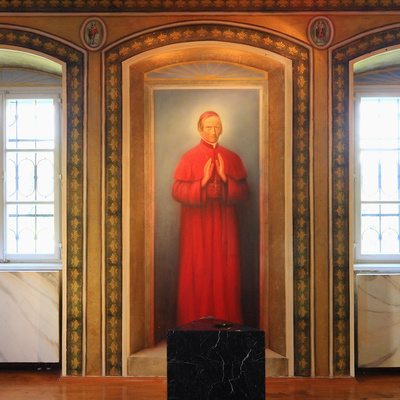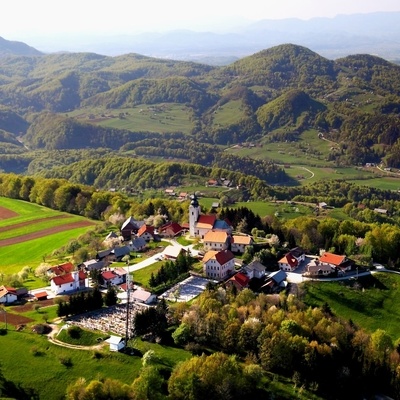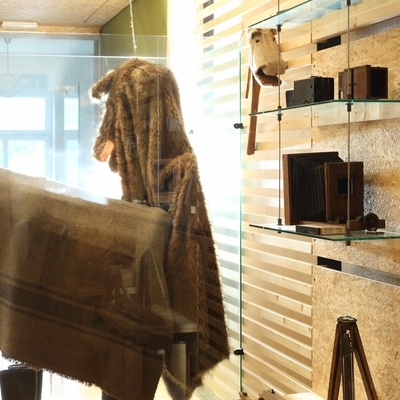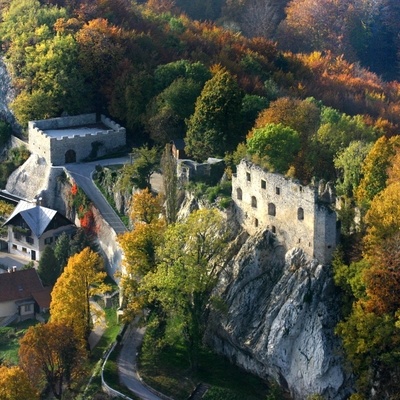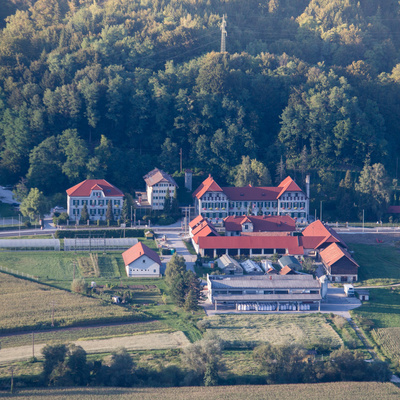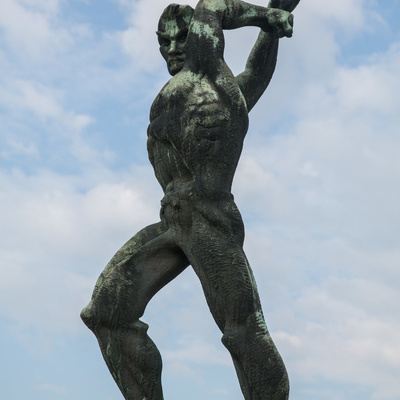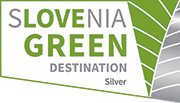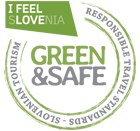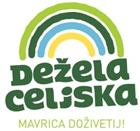Cultural Heritage
Zgornji trg Square Šentjur
Most beautiful town square of 2015
The old town square has a particularly special place in the history of the Slovenian nation and patriotism and was first mentioned in 1340 as a settlement around the church of St. George.
Ipavec House
The birth house of the Ipavec dynasty, a dynasty of composers, doctors, great patriots and Europeans has stood in the Zgornji trg Square since 1760. The house hosts a permanent exhibition on the Ipavec family, a wedding hall, wine cellar, a smaller ...
Commemorative Room of the New Swing Quartet – Song of the Southern Railway
The commemorative room with its permanent exhibition seeks to inform visitors of the history and activities of the Quartet and its importance in the Slovenian and international arenas.
Memorial on Resevna Hill
On the meadow alongside the parking area is a monument with the words: Just before achieving freedom, 80 heroic fighters fell in action here at Resevna; the entire 2nd battalion of the Kozjansko detachment and commander Andi Šepetavec, the ...
Zgornji trg Square Gallery
The vaulted cellar presents painting and sculptural masterpieces of local and guest artists at temporary exhibitions. It is also suitable for smaller events.
Museum of the Southern Railway Šentjur
The picturesque display of the reconstruction of the railway station will take you back to the time of the birth of the Graz-Celje railway line.
Rifnik Archaeological Park
The hill above Šentjur, which has been inhabited since the Neolithic era, is now converted into an archaeological park at the site of the largest late antique settlement in Slovenia
Museum Collection Rifnik and its treasures
In the old town square opposite the Parish Church of St. George there is an archaeological exhibition, which depicts thousands of years of Rifnik’s history.
Rifnik Castle
The tower is still preserved to a height of three storeys and has Gothic windows with wall seats and frames with trimmed edges. The ruins of the Rifnik Castle stand on a rocky prominence of the hill bearing the same name. The castle was first ...
Ferlež Mill
During your visit you will meet the owner of the mill, Karol Ferlež who will tell you interesting stories about the history of the mill and the surrounding area.
Millstones Caves
During the Austro-Hungarian Empire, the largest area for the carving of millstones was located on the Rifnik and Resevna slopes and above the Kozarica valley.
Birth House of Anton Martin Slomšek
The beatified Anton Martin Slomšek was born in 1800 in the village of Uniše near Ponikva. His birth house was restored and is open to visitors throughout the year. The house contains an exhibition which follows the life of the esteemed priest, ...
Ponikva Memorial Park
The NOB monument is located in the Ponikva Memorial Park and on the 25th anniversary of Slovenia's independence, a tetrahedron (a former anti-tank barrier from the war for Slovenia’s independence) was erected with the inscription: "In memory of the ...
Astronomical Observatory
The astronomical observatory is a special attraction of the school, which due to the absence of light pollution presents a perfect location for observing the southern sky. Every year at the end of July, there is also an astronomy night here. ...
Lončarstvo Buser
Živa Zupanc Buser nadaljuje družinsko tradicijo z izdelovanjem unikatnih izdelkov iz gline. V delavnici si je mogoče ogledati izdelavo in izdelke tudi kupiti, organizirane pa so tudi delavnice za skupine. Informacije Telefon: 00386 (0)41 948 ...
Partisan Hospital Zima
The hospital was built by the locals as an underground bunker in 1944 on the orders of the divisional staff of the XIVth Division. They found a location in the Šohta forest. There was enough water and the place could be kept hidden in the winter ...
Kalobje manuscript
The Kalobje manuscript, also known as Liber cantionum Carniolicarum or the Book of Carnolian Poems arose in the middle of the 17th century and contains 44 poems with prayers and catechism in the Slovene language of the central and western type. ...
Early Glassworks in the Žusem area Museum Collection
The Church of St. Leopold with its furnishings and displayed items is a real glassworks museum, which has been present in Loka and its surroundings since the middle of the 18th century. Here you can view beautiful glass products and especially the ...
R-6 partisan hospital in Javoršica
The hospital was partially buried, had a rectangular floor plan and was built of logs and covered with roof felt, which was covered with soil. The hospital bearing the name R6 was built in 1944. It had room for 12 wounded persons, a nurse, a cook and ...
Planina Museum Collection – Šmid Ethnological Collection
During his many years of service in Planina, the family physician Janez Šmid started a collection of ethnological items. He was interested in the folk heritage which was vanishing right before his eyes, and began collecting characteristic items from ...
Kozjansko Glows Permanent Exhibition
The Celje Museum of Recent History has opened the permanent exhibition called Kozjansko Glows in Planina on the first floor of the old Health Centre. The images and texts acquaint visitors with the period of World War II in the Kozjansko region, ...
Charm Of Tradition
Life and work of Academician dr. Niko Kuret (1906 – 1995)
Life and work of Academician dr. Niko Kuret (1906–1995). Through his study room we enter the world of rich scientific and research work in the area of ethnography. At the same time we are discovering his immense human breadth, creative energy and ...
Alfonz Jurše - Life Through a Lens
Photography exhibition Planina 1903–1945
More than 3500 stories captured through the lens represent a priceless chronicle of a certain place and time. His photography opus is a story of a life in Planina in the first half of the 20th century which actually never ends. Location of ...
Planina Castle
The ruins of the former castle are situated on the cliff overlooking the market town Planina pri Sevnici. The core of the ruins is Romanesque, while the southern castle wall is Gothic. The entrance and part of the defensive wall in the north-west are ...
Pillory in Planina pri Sevnici
Opposite the Church of St. Margaret, you can view the pillar of shame - a pillory, which was built in 1999 on the original site where it once stood.
Castle park in Planina pri Sevnici
We can find a chestnut and linden tree avenue, as well as the famous Turkish linden tree, planted after the Turks attacked Planina in the restored castle park. In the battle, the lords of the Castle of Planina defeated the Turks, also killing a ...
Commemorative Room of Blaž Kocen
The geographer and cartographer Blaž Kocen was born in 1821 in the village of Hotunje. After finishing high school and lyceum in Graz, he continued his studies in theology in Klagenfurt. As chaplain, he served in various places in Lower Styria until ...
Agricultural School and outbuildings
Regular classes began in January 1910 as the first school of this kind with Slovenian as the language of instruction in the Habsburg Monarchy.
War Memorials
A number of memorials commemorates World War 2 and War for Slovenian independance. Memorial of the Independence of the Republic of Slovenia at the Town Square Monument to the 132 Victims of the National Liberation War and Franjo Malgaj ...
